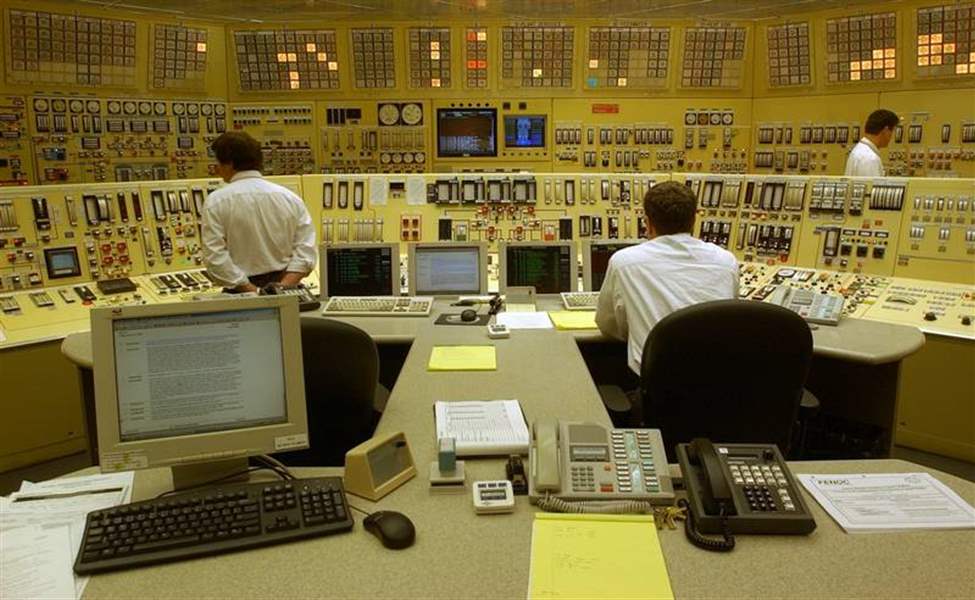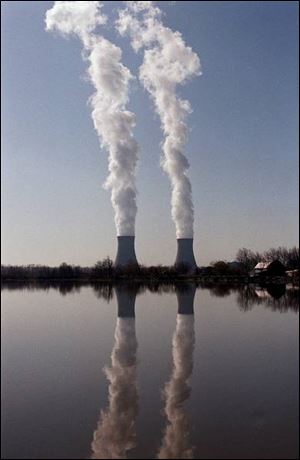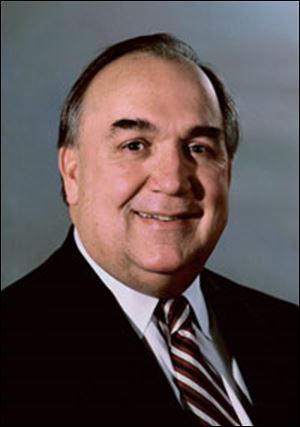
Industry ready to fuel nuclear power rebirth
5/14/2006
Nuclear reactor operators work inside the control room at Davis Besse Nuclear Power Station in Oak Harbor.

The Detroit Edison fermi II Nuclear Power Plant in Frenchtown Township, Michigan, show in 2001, is expected to be back at full power soon, after being offline for maintenance.
Former Michigan Gov. John Engler is expected to help pump a little more life into America s nuclear industry this Thursday when he delivers a pitch in San Francisco for more nuclear plants on behalf of the nation s manufacturing sector.

Engler
Mr. Engler, now president and chief executive officer of the Washington-based National Association of Manufacturers, is to address more than 350 executives, including those from the nation s largest utilities, in the ballroom of the Fairmont San Francisco after taped video remarks by President Bush are aired that morning.
The event, called the Nuclear Energy Assembly, is the annual conference of the Nuclear Energy Institute, the industry s chief lobbyist group on Capitol Hill. An NEI spokesman confirmed that it is paying to have Mr. Engler flown out to deliver the speech.
He s being courted for an obvious reason: To help the nuclear industry make a comeback.
The industry has been struggling to overcome the stigma of the partial meltdown of the Three Mile Island Unit 2 reactor in Pennsylvania in 1979; this year s 20th anniversary of the 1986 Chernobyl disaster near Kiev, Ukraine, and the near-rupture of the Davis-Besse nuclear reactor head 30 miles east of Toledo in 2002. The latter resulted in a $28 million fine Jan. 20 against FirstEnergy Corp., the largest in U.S. nuclear history, and federal indictments of three former employees whose cases may go to trial in Toledo this fall.
Mr. Engler s support albeit a small part of the big picture is the latest sign the campaign to revive the nuclear industry might just be getting some momentum.
Less than three weeks ago, on April 24, the NEI announced the formation of the Clean and Safe Energy Coalition (CASEnergy) to ramp up its message. The coalition, funded by the NEI, has 50 charter member organizations, including Detroit Edison s parent, DTE Energy; the U.S. Chamber of Commerce; Mr. Engler s group, and the International Brotherhood of Teamsters. FirstEnergy is not on the list.
The significance of the CASEnergy announcement was the tandem who will serve as co-chairs: Christine Todd Whitman, a former New Jersey governor and the first U.S. Environmental Protection Agency administrator to serve under Mr. Bush, and Patrick Moore, a Greenpeace co-founder who has gained attention for his aggressive pursuit of more nuclear power as a means of addressing global warming.

Nuclear reactor operators work inside the control room at Davis Besse Nuclear Power Station in Oak Harbor.
Engler pushing need for nuclear energy
Mr. Engler declined to be interviewed about his upcoming speech. But his association s Web site shows it will be at least the fourth he will have delivered about the general need for more energy since April 11.
The San Francisco speech will be Mr. Engler s first devoted exclusively to nuclear power on behalf of the National Association of Manufacturers, said his spokesman, Hank Cox, who provided a couple of snippets from past speeches that reveal Mr. Engler s fundamental position.
The public is displaying a renewed willingness to consider nuclear power, Mr. Engler said during an April 26 speech in Montgomery, Ala.
On Nov. 15, 2005, while addressing a Rockwell Automation audience in St. Louis, Mr. Engler said nuclear energy holds great promise as a clean, safe, unlimited source of power for our nation.
We already produce one quarter of the world s nuclear power, he said. We can do more.
Yes, America can produce more nuclear power. This nation invented it. But does it want to produce more?
Costs, rather than rules, halted nuclear growth
Contrary to what many people think, nuclear power didn t become stagnant because of post-Three Mile Island regulations.
Even the Nuclear Regulatory Commission an agency rooted in promoting nuclear power itself back when it began as the Atomic Energy Commission is quick to point out that Wall Street had a bigger influence.
The last application to build a nuclear plant was submitted to the NRC months before the Three Mile Island accident. The construction era came to a halt because projects came in millions of dollars over budget.
David Garman, a U.S. Department of Energy under secretary, has said that nuclear power is such a sensitive issue that many public utility boards know better than to put a discussion about new plant construction on their agenda. Doing so hurts their company stock, he said.
Such fears haven t discouraged Ms. Whitman or Mr. Moore.
Our country s significant energy needs keep growing. We must diversify our energy sources to meet these needs, Ms. Whitman said. Mr. Moore said nuclear power has proven itself an environmentally sound and safe energy choice. He advocates doubling America s nuclear energy production to curb greenhouse gases that cause global warming.
Nuclear provides 20 percent of the nation s electricity and is second to coal, which produces half. Coal-fired power plants also are the largest source of greenhouse gases.
Nuclear has its ownenvironmental hurdles
While nuclear plants themselves release no greenhouse gases, the process of enriching uranium for their reactor fuel rods requires huge draws from the nation s energy grid. Critics such as Dr. Helen
Caldicott of the Physicians for Social Responsibility, a 1985 nominee for the Nobel Peace Prize, have told The Blade that the industry s claim of being emissions-free is misleading because electricity from coal-fired power plants invariably is used to enrich the uranium.
The nuclear industry also still has to overcome its biggest hurdle: Waste disposal. Spent reactor fuel rods are the only material in civilian hands classified as high-level radioactive waste. Nevada s
Yucca Mountain has crossed many of the regulatory hurdles to become the federal disposal site. But it is still years away from being developed, if it ever is.
Mr. Moore left Greenpeace in 1986. His old group pre-empted the announcement about his pairing with Ms. Whitman by issuing a report that alleges America has had 200 near-misses since the Chernobyl explosion. The 2002 incident at Davis-Besse was ranked No. 1.
Jim Riccio, Greenpeace s nuclear policy analyst in Washington, said the industry s safety record is far from stellar, despite fewer documented injuries compared to some other major industries. He said high-end construction and maintenance costs for new nuclear plants will continue to be the greatest deterrent.
For the first time in history, nuclear plants have to be competitive, and they re not, Mr. Riccio said. He said deregulation does not allow state public service commissions to pass along construction costs to ratepayers as the agencies did in the past.
The NEI refutes such claims. On Sept. 8, its senior director of business and environmental policy, Richard Myers, told the World Nuclear Association that the industry will prevail because it has worked to peel apart systematically the risks and business issues that exist at each stage of project development..
Mr. Bush and his allies, including U.S. Rep. George Voinovich (R., Ohio), continue to play key roles. Mr. Voinovich has co-sponsored and helped push for legislation aimed at rejuvenating the nuclear industry, including the reauthorization of the 1957 Price-Anderson
Act that put a cap on a utility s liability in the event of anaccident. Through his position on the Senate Environment and Public Works Committee, Mr. Voinovich has been a proponent of streamlining regulations and in bringing back retired NRC employees at full pay as consultants to help the agency maintain some of its institutional knowledge.
Edward McGaffigan, a Democrat and one of five NRC board members, acknowledged some of the agency s shortcomings as a government watchdog. He said it learned a hard lesson from and was embarrassed by the Davis-Besse debacle.
I think [the public] knows that if we screw up, that ll be the end of the nuclear renaissance, he said.
Contact Tom Henry at:thenry@theblade.comor 419-724-6079.